You’ll find Costa Rica’s premium coffee beans processed through meticulous methods honed over generations.
Farmers hand-pick ripe cherries at elevations of 5,000-7,000 feet, then employ either wash, honey, or natural processing techniques.
The wash method removes fruit through fermentation tanks, honey processing preserves the bean’s natural sweetness, and natural processing sun-dries cherries for up to 35 days.
These carefully controlled steps reveal the region’s signature bold, sweet, and complex flavor profiles.
Key Takeaways
- Costa Rican farmers hand-pick only the ripest coffee cherries at elevations between 5,000-7,000 feet during morning harvesting hours.
- Traditional wash processing separates beans from cherries through water-filled drums, followed by 12-48 hours of fermentation.
- Honey processing preserves bean sweetness by removing cherry skin while keeping mucilage intact through centrifugal force.
- Sun-drying techniques on raised beds require 35 days of careful rotation to develop complex flavor profiles.
- Beans undergo a three-month resting period after processing, with 95% meeting strict export standards for premium quality.
The Art of Hand-Picking Costa Rican Coffee
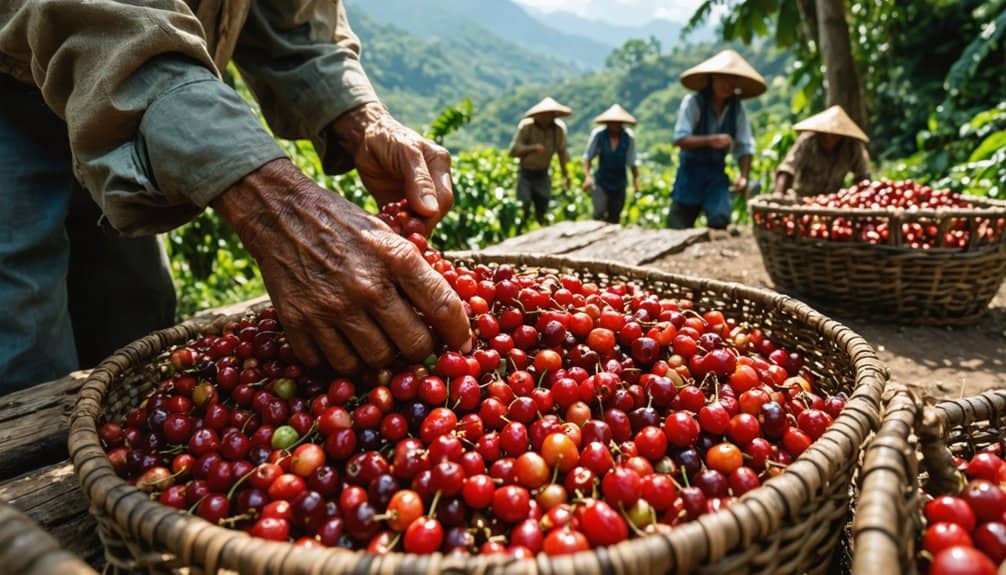
While Costa Rica’s coffee industry spans diverse regions, the artisanal process of hand-picking remains remarkably consistent across its mountainous terrain.
You’ll find dedicated peones starting their work at 6:30am, each assigned to specific calles where they’ll spend 8-9 hours carefully selecting cherries.
Workers receive three full meals daily to sustain their energy throughout the physically demanding harvest.
You’re part of a tradition that demands precision: twisting ripe cherries to the left, protecting green buds, and filling your canasta with only the reddest fruit.
In this community, experienced pickers like Efrem often share prime calles with families in need, while quality control guarantees every cajuela meets the exacting standards that define Costa Rica’s coffee excellence.
From Cherry to Bean: The Harvest Timeline
The voyage from coffee seed to exportable bean spans nearly two years of careful cultivation and precise timing.
You’ll find farmers nurturing seedlings for 14 months in shaded nurseries before transplanting them during June’s wet season.
After planting, you’ll wait another year for the primary blooms to appear, followed by seven to nine months until the initial harvest.
Your cherries won’t all ripen simultaneously, requiring three separate hand-pickings over four months, typically from November to February.
Most beans are grown at 5,000 to 7,000 feet elevation where Arabica coffee thrives best.
Once harvested, you’ll process the beans using either the wash or honey method, followed by an essential three-month resting period before export.
Traditional Wash Processing Methods
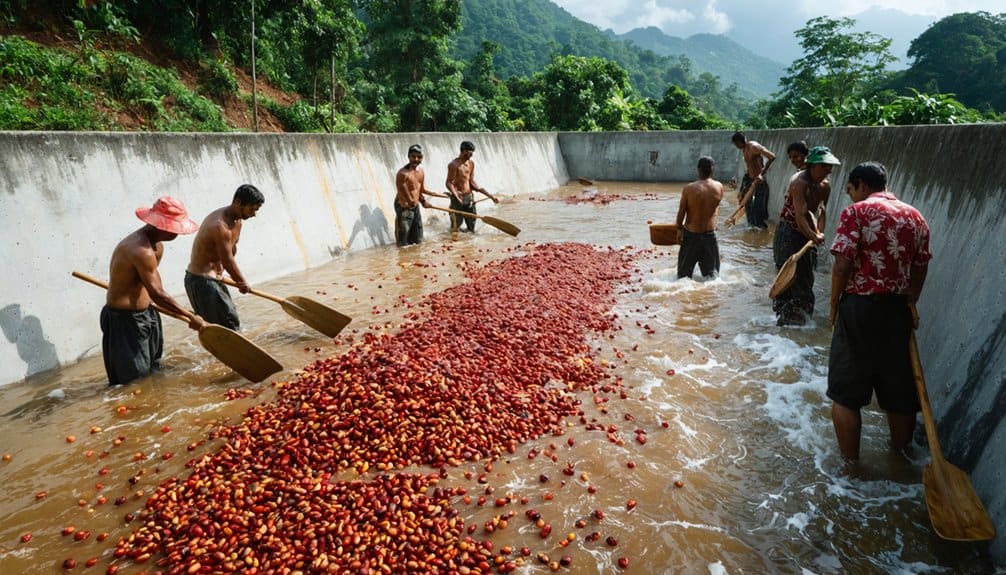
Once your cherries reach peak ripeness, traditional wash processing begins with meticulous sorting to remove any defective or substandard beans.
You’ll then pulp the cherries to separate the fruit flesh from the beans, using rotating drums filled with water to sort by weight and size.
Quality coffee production requires dedicated artisans working together throughout the process.
Next, you’ll submerge your beans in fermentation tanks for 12-48 hours, allowing the mucilage to naturally dissolve.
After a thorough washing, you’ll dry the beans either mechanically or under the sun until they reach 11% moisture content.
This process, taking up to a week, guarantees your beans develop that clean, balanced flavor profile Costa Rica is known for.
The Sweet Science of Honey Processing
Since honey processing revolutionized Costa Rican coffee production, farmers have adopted this creative method that strikes a perfect balance between natural and washed techniques.
Drawing from traditional honey extraction principles, you’ll find farmers using centrifugal force and careful straining to preserve the bean’s inherent sweetness.
Just as beekeepers remove wax cappings before extraction, coffee producers strip the cherry’s outer skin while leaving the mucilage intact.
The process requires precise timing and monitoring, much like the floating method used in honey production, where patience and attention to detail secure ideal results.
The beans must be processed in bee-proof spaces to prevent contamination and ensure optimal quality.
Natural Processing: Sun-Dried Excellence
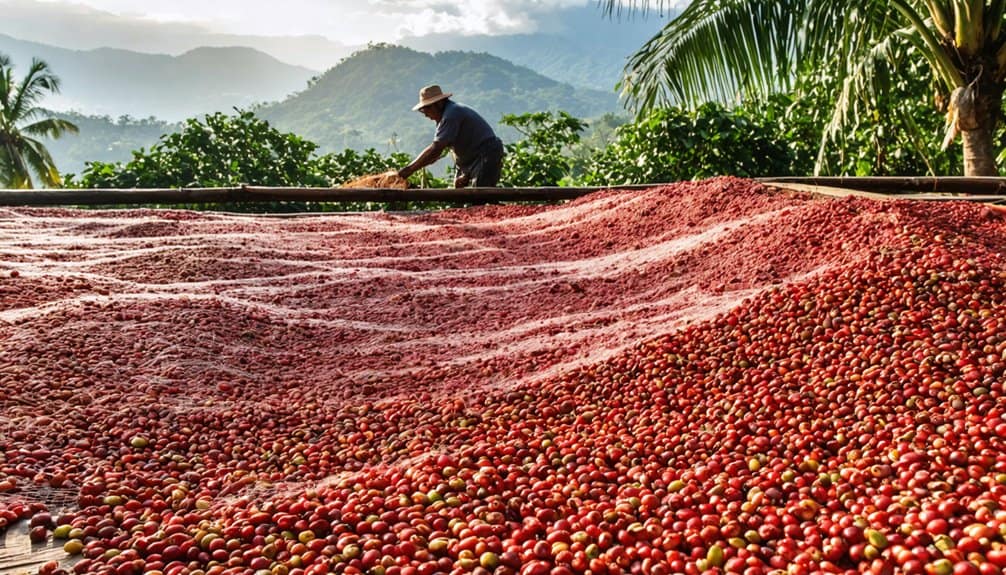
You’ll find Costa Rican farmers carefully spreading their freshly picked coffee cherries across raised drying beds, where the cherries will bask in the sun’s warmth for up to 35 days.
During this lengthy natural process, you’ll witness farmers meticulously rotating the cherries throughout each day and protecting them at night, ensuring even drying while the fruit’s sugars slowly infuse into the beans.
Your patience with this traditional method yields remarkable results: beans with improved body, concentrated sweetness, and complex flavor notes ranging from chocolate to bright citrus.
At the renowned Hacienda Doka Estate, expert farmers have perfected this double sun-drying technique at elevations between 1350-1410 meters above sea level.
Traditional Sun-Drying Methods
For generations, Costa Rican farmers have perfected the art of natural sun-drying coffee cherries, a meticulous process that can span up to 35 days depending on weather conditions.
You’ll find their expertise reflected in how they spread ripe cherries across drying beds, carefully rotating them throughout the day and protecting them from evening moisture.
In this environmentally conscious method, you’re letting nature do the work until the cherries reach 11 percent moisture content.
While this technique requires more labor than other processes, you’re preserving the bean’s natural sweetness and creating distinct fruity flavors that you won’t find in washed or honey-processed coffees.
The heavy body and sugar in naturally processed beans creates a uniquely rich coffee experience.
Flavor Profile Development
While natural processing methods shape Costa Rica’s distinctive coffee profiles, the sun-drying technique particularly excels at cultivating complex flavor characteristics.
You’ll find out how beans absorb sugars from their mucilage during this process, creating a sweeter profile with improved chocolate and fruit notes.
The method preserves natural oils, reducing acidity while building a heavier body.
The country’s strict commitment to 100% Arabica beans ensures exceptional quality throughout the natural processing approach.
Each region’s microclimate adds its signature: Tarrazú’s bold tanginess, Valle Occidental’s fruity complexity, and Guanacaste’s smooth, subtle saltiness.
When compared to washed or honey processing, you’re getting a more balanced, complex cup – exactly what makes Costa Rica’s naturally processed beans so sought after by coffee enthusiasts worldwide.
Lengthy Six-Week Process
The natural processing of Costa Rica’s coffee cherries demands a meticulous six-week voyage from harvest to export-ready beans.
You’ll find farmers spreading freshly picked cherries across sun-drenched beds, where they’ll spend the next 35 days developing their signature flavors.
Once the cherries reach their optimal 11% moisture level, they’re ready for the next phase of processing.
Each day, you’re part of a careful dance: rotating cherries, ensuring even drying, and protecting them from night moisture.
While this sun-dried method requires more time than washed or honey processing, you’re preserving the bean’s connection to Costa Rica’s volcanic terroir.
After drying, your beans will rest for three months, allowing their complex, wine-like notes to fully mature.
Time and Temperature in Coffee Drying
Coffee drying methods in Costa Rica employ distinct time-temperature relationships based on processing type, with natural process taking up to 6 weeks, honey process requiring 4-6 weeks, and washed process needing 2-3 weeks.
As a coffee farmer, you’ll need to master these crucial time controls:
- Natural process requires constant rotation of cherries on patios with sun exposure
- Honey process demands hourly bean rotation for 10-15 days on thin drying beds
- Washed process includes centrifuge spinning after machine cleaning
- Mechanical drying offers faster alternatives during unpredictable weather
Climate change is pushing our community toward mechanical drying methods, though traditional sun-drying still produces exceptional results when conditions permit.
The country’s focus on Arabica cultivation continues to influence processing decisions, as these premium beans require precise drying techniques.
Beyond the Husk: Peeling and Green Bean Preparation
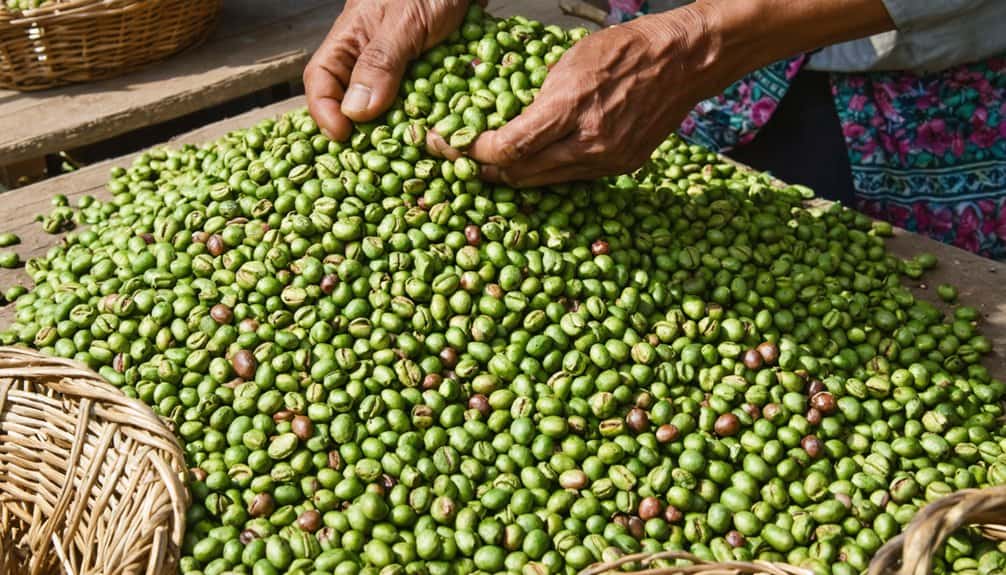
Since proper peeling marks a critical change from dried cherries to exportable green beans, Costa Rican farmers must master precise mechanical and quality control processes during this phase.
You’ll find specialized grinders at peeling stations where the parchment layer is carefully removed while maintaining strict quality segregation.
After peeling, your beans need 3-4 months of aging to develop their distinct flavor profiles.
During this time, you’re participating in Costa Rica’s proud tradition of excellence – 95% of these beans will meet export standards.
Whether using wet or honey processing methods, you’re ensuring ideal mucilage removal and fermentation for premium green coffee that’ll represent your farm globally.
Over 70 percent of farms incorporate sustainable emission reduction practices while processing their beans.
Small Farms, Big Impact: The Family Farm Legacy
Along Costa Rica’s mountainous regions, small family farms dominate the landscape, cultivating premium Arabica beans at elevations between 5,000-7,000 feet.
These family operations prioritize quality over quantity, utilizing generations of expertise to produce exceptional coffee.
In the Central Valley region, urban development threats have pushed many traditional farms to adopt more sustainable methods to preserve their agricultural heritage.
You’ll find these farms adopt time-tested traditions while adapting to modern challenges:
- Hand-picking every bean at peak ripeness
- Processing through wash or honey methods
- Implementing sustainable shade-tree cultivation
- Operating independent processing facilities
This legacy of small-scale farming yields more than just superior coffee – it preserves traditional knowledge, supports local communities, and promotes environmental stewardship through reduced agrochemical use and improved biodiversity.
Quality Control in Costa Rican Processing
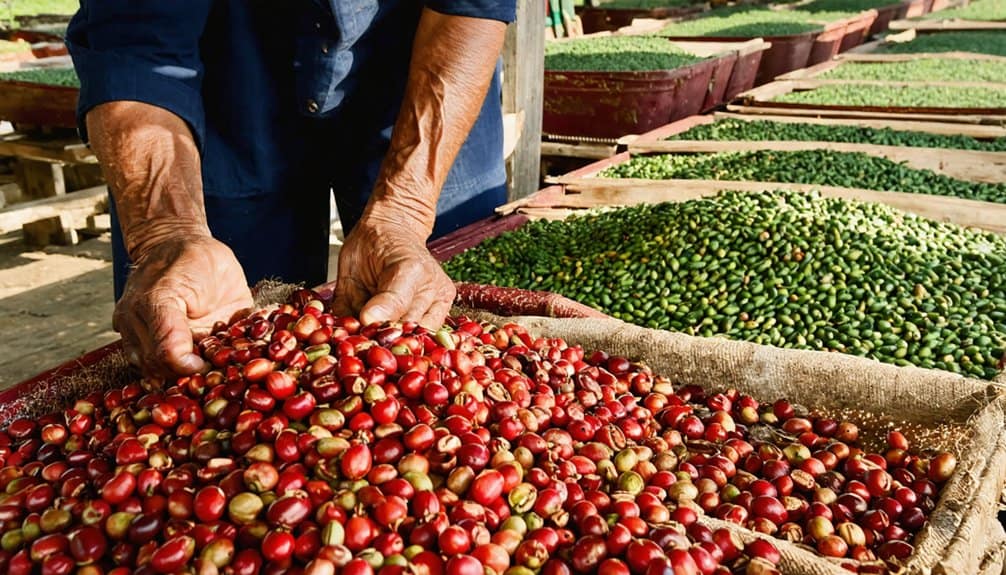
Costa Rica’s strict hand selection standards require you to pick only the ripest coffee cherries, ensuring ideal flavor development and uniform quality throughout the harvest.
At the mill, you’ll need to pass multiple inspection checkpoints that evaluate bean size, density, and moisture content while adhering to either wet, honey, or natural processing methods.
Before export, your beans must meet rigorous grade requirements including proper classification by altitude, successful chromatography testing, and compliance with ICAFE’s sustainable agriculture protocols.
The Coffee Quality Institute closely monitors sensory evaluations, ensuring every batch meets high cupping scores before certification.
Hand Selection Standards
Quality control specialists and veteran farmers in Costa Rica have developed rigorous hand-selection standards that define the region’s coffee excellence.
These standards guarantee that you’ll receive beans that meet strict certification requirements from ICAFE and CQI.
- You’ll find SHB-certified beans grown above 3,900 feet, where altitude improves density and flavor complexity
- EP designation confirms thorough hand-sorting to remove defects
- Selective harvesting assures only ripened cherries make it to processing
- Wet, honey, or natural processing methods preserve distinctive flavor profiles
Clean raw beans are essential for achieving superior cup profiles.
These meticulous standards have positioned Costa Rica as a premier coffee producer since 1989.
Mill Inspection Protocols
When processing Costa Rica’s finest coffee beans, mills must operate under rigorous inspection protocols that extend far beyond basic quality checks.
You’ll find stringent environmental standards requiring proper wastewater management and buffer zones between organic and conventional crops.
Each mill undergoes regular audits to verify compliance with certifications that protect both product quality and worker welfare.
In these facilities, you’re not just seeing coffee production – you’re witnessing a commitment to excellence.
Mills provide crucial worker benefits including healthcare and education while maintaining strict cleaning protocols.
These facilities carefully separate and evaluate different coffee pick grades to ensure optimal quality levels.
This all-encompassing approach guarantees you’re getting beans processed under the highest standards of quality and sustainability.
Export Grade Requirements
The export requirements for Costa Rican coffee reflect a pioneering shift toward environmental stewardship and sustainability.
When you’re preparing your coffee for export, you’ll need to meet stringent criteria that align with both traditional quality standards and modern environmental commitments.
The beans must come from Arabica coffee only, as mandated by Costa Rican law since 1989. Your export-grade coffee must satisfy these critical requirements:
- Deforestation-free certification dating back to 2020
- Complete farm georeference documentation
- EU Green Deal compliance verification
- Standard quality metrics for moisture, defects, and bean size
You’re part of Costa Rica’s commitment to sustainable coffee production, setting new standards for global markets, particularly for premium destinations like Italy.
Modern Innovations in Traditional Methods
Modern Costa Rican coffee farmers have revolutionized traditional processing methods by developing creative techniques like honey processing and anaerobic fermentation.
You’ll find these innovations improve both quality and sustainability while maintaining Costa Rica’s reputation for excellence.
The semi-washed approach leaves some fleshy coating on the beans during honey processing.
| Process | What You’ll Experience |
|---|---|
| Honey | Sweet, complex notes with chocolate undertones |
| Anaerobic | Distinct hibiscus and plum characteristics |
| Washed | Bright, clean cup with crisp acidity |
| Natural | Full-bodied with intense fruit flavors |
These methods demonstrate your farmers’ commitment to crafting unique flavor profiles while honoring traditional techniques.
The controlled fermentation and precise drying processes reflect their deep understanding of coffee science, ensuring you receive consistently exceptional beans.
FAQs
How Much Do Costa Rican Coffee Farmers Typically Earn per Harvest Season?
You’ll find Costa Rican coffee farmers earn roughly 20% of coffee’s final value, with their profits dropping 20-25% recently due to currency fluctuations, high input costs, and reduced harvests.
What Percentage of Costa Rican Coffee Farms Are Certified Organic?
You’ll find that only 1% of Costa Rica’s coffee farms maintain organic certification today, a significant drop from 30 years ago when 8% operated under organic practices and standards.
How Do Climate Changes Affect Coffee Processing Methods in Costa Rica?
In a world where rain’s become our enemy, you’ll find erratic rainfall patterns wreaking havoc on your drying times, while rising temperatures force you to adjust fermentation periods and moisture-control methods.
Which Coffee Varieties Are Most Commonly Grown in Costa Rica?
You’ll find Caturra and Catuai dominating Costa Rica’s coffee landscape, accounting for 90% of production. Typica and Bourbon varieties also thrive in the volcanic soils at high altitudes.
What Environmental Regulations Must Costa Rican Coffee Processors Follow?
You’ll need to comply with EU deforestation regulations, maintain NAMA Café’s low-carbon standards, and follow ICAFE’s due diligence requirements while ensuring no forest conversion occurred after December 2020 for coffee production.
The Bottom Line
As you’ve uncovered, Costa Rican coffee processing isn’t just about transforming nature’s gifts – it’s a delicate dance between tradition and innovation.
You’ll find that these stewards of the land have mastered the art of coaxing excellence from every cherry while treading lightly on their precious soil.
Their methods, whether sun-kissed natural processing or gentle water washing, guarantee you’re experiencing the purest expression of Costa Rica’s blessed mountainsides in every cup.
